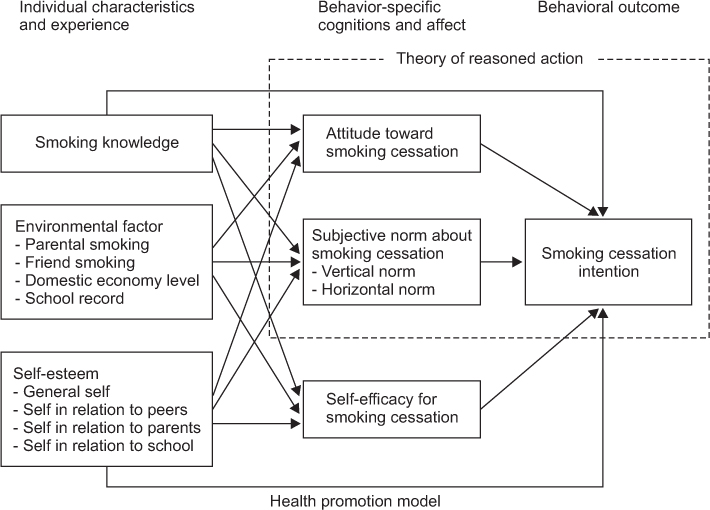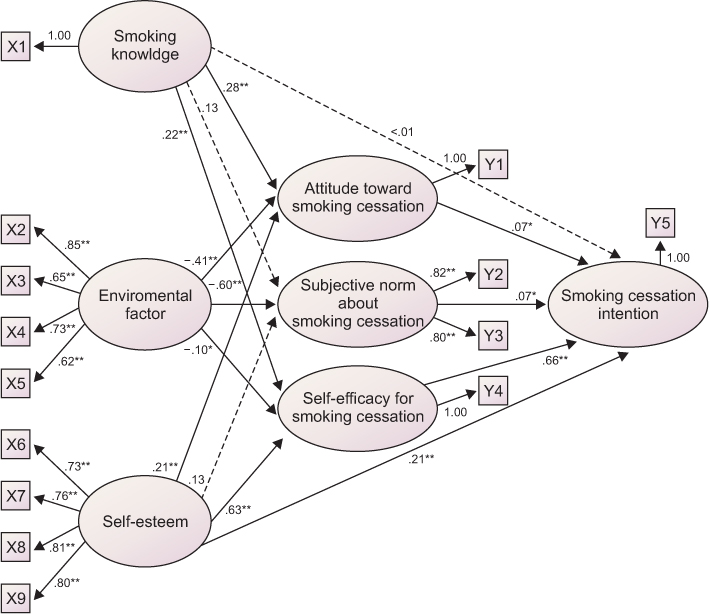J Korean Acad Nurs.
2017 Apr;47(2):211-221. 10.4040/jkan.2017.47.2.211.
Structural Equation Modeling on Smoking Cessation Intention in Male Technical High School Students
- Affiliations
-
- 1Department of Nursing, College of Deagu Health, Daegu, Korea.
- 2College of Nursing · The Research Institute of Nursing Science, Kyungpook National University, Daegu, Korea. eschoi2007@knu.ac.kr
- KMID: 2426347
- DOI: http://doi.org/10.4040/jkan.2017.47.2.211
Abstract
- PURPOSE
This study was done to develop and test a structural model on smoking cessation intention in technical high school men. The conceptual model was based on the theory of reasoned action and health promotion model.
METHODS
From May 29 to April 13, 2015, 413 technical high school students who smoked completed a structured questionnaire. Data were analyzed to calculate the direct and indirect effects of factors affecting smoking cessation intention. The SPSS WIN 20.0 and AMOS 21.0 programs were used.
RESULTS
The hypothetical model was a good fit for the data. The model fit indices were χ²/df=2.36, GFI=.95, AGFI=.92, NFI=0.97, and RMSEA=.05. Self-esteem had direct and indirect effects on smoking cessation intention. Attitude, subjective norm, and self-efficacy had direct effects on smoking cessation intention. Smoking knowledge and environmental factor had indirect effects on smoking cessation intention. This model explained 87.0% of the variance in smoking cessation intention.
CONCLUSION
These results indicate that technical high school students' intention to stop smoking can be improved through an increase in self-esteem, negative environmental factors, attitude toward smoking cessation, subjective norm about smoking cessation, and self-efficacy for smoking cessation.
Keyword
MeSH Terms
Figure
Reference
-
1. Ministry of Health & Welfare. Drastically raise cigarette prices in 10 years [Internet]. Sejong: Author;2014. cited 2014 December 3. Available from: http://www.mohw.go.kr/front_new/al/sal0301vw.jsp?PAR_MENU_ID=04&MENU_ID=0403&page=5&CONT_SEQ=308121&SEARCHKEY=CONTENT&SEARCHVALUE=.2. Ministry of Health & Welfare, Korea Centers for Disease Control & Prevention. Korea health statistics 2014: Korea national health and nutrition examination survey (KNHANES VI-2). Sejong: Ministry of Health & Welfare;2015.3. Bae SG. The relationships of student academic engagement with learning psychological variables and teacher instructional behavior in specialized vocational high schools [dissertation]. Seoul: Seoul National University;2013. 1–171.4. Kim JE, Cho BH. The impact of social relationships on adolescents' smoking behavior. Stud Korean Youth. 2012; 23(1):57–87.5. Ajzen I, Fishbein M. Understanding attitudes and predicting social behavior. Englewood Cliffs, NJ: Prentice-Hall;1980. p. 82–150.6. Haug S, Schaub MP, Schmid H. Predictors of adolescent smoking cessation and smoking reduction. Patient Educ Couns. 2014; 95(3):378–383. DOI: 10.1016/j.pec.2014.03.004.7. Høie M, Moan IS, Rise J, Larsen E. Using an extended version of the theory of planned behaviour to predict smoking cessation in two age groups. Addict Res Theory. 2012; 20(1):42–54. DOI: 10.3109/16066359.2011.557165.8. DiClemente CC, Prochaska JO, Gibertini M. Self-efficacy and the stages of self-change of smoking. Cognit Ther Res. 1985; 9(2):181–200. DOI: 10.1007/BF01204849.9. Park MK, Kang KS, Kim NY. A study on Korean adults' health status, smoking perception, and self-efficacy of smoking cessation according to smoking status. J Korean Acad Community Health Nurs. 2006; 17(1):83–90.10. Spek V, Lemmens F, Chatrou M, van Kempen S, Pouwer F, Pop V. Development of a smoking abstinence self-efficacy questionnaire. Int J Behav Med. 2013; 20(3):444–449. DOI: 10.1007/s12529-012-9229-2.11. Kim JY, Park SW. Predictors of current smoking among male students in a technical high school: A prospective study. J Prev Med Public Health. 2009; 42(1):59–66. DOI: 10.3961/jpmph.2009.42.1.59.12. Wang Y, Krishnakumar A, Narine L. Parenting practices and adolescent smoking in mainland China: The mediating effect of smoking-related cognitions. J Adolesc. 2014; 37(6):915–925. DOI: 10.1016/j.adolescence.2014.06.010.13. Shin SR, Jeong GC. Predictive variables on intention to stay as a nonsmoker based on educational environment related factors. Health Soc Sci. 2007; 21:5–24.14. Hiemstra M, Otten R, de Leeuw RN, van Schayck OC, Engels RC. The changing role of self-efficacy in adolescent smoking initiation. J Adolesc Health. 2011; 48(6):597–603. DOI: 10.1016/j.jadohealth.2010.09.011.15. Povey R, Conner M, Sparks P, James R, Shepherd R. The theory of planned behaviour and healthy eating: Examining additive and moderating effects of social influence variables. Psychol Health. 2000; 14(6):991–1006. DOI: 10.1080/08870440008407363.16. Guo Q, Johnson CA, Unger JB, Lee L, Xie B, Chou CP, et al. Utility of the theory of reasoned action and theory of planned behavior for predicting Chinese adolescent smoking. Addict Behav. 2007; 32(5):1066–1081. DOI: 10.1016/j.addbeh.2006.07.015.17. Su X, Li L, Griffiths SM, Gao Y, Lau JT, Mo PK. Smoking behaviors and intentions among adolescents in rural China: The application of the theory of planned behavior and the role of social influence. Addict Behav. 2015; 48:44–51. DOI: 10.1016/j.addbeh.2015.04.005.18. Ahn HY, Lee J. Survey on adolescents' knowledge and attitudes as related to temptation toward cigarette smoking. J Korean Acad Child Health Nurs. 2009; 15(4):367–374. DOI: 10.4094/jkachn.2009.15.4.367.19. Pender NJ, Murdaugh CL, Parson MA. Health promotion in nursing practice. 4th ed. Upper Saddle River, NJ: Prentice Hall;2002.20. Choi EY, Jeong EY. The effect of self-efficacy promotion smoking cessation program on the amount of smoking, CO, urine cotinine level and self-efficacy for adolescent smokers. J Korean Biol Nurs Sci. 2012; 14(2):103–111. DOI: 10.7586/jkbns.2012.14.2.103.21. Kim YS. The effects of a self-esteem and smoking cessation self-efficiency improvement program on smoking high school students. J Korean Acad Community Health Nurs. 2011; 22(2):121–130. DOI: 10.12799/jkachn.2011.22.2.121.22. Jeong JS. A study on the impact of adolescent smoking characteristics on the attitude toward anti-smoking advertisements -application of the extended planned behavior model. Advert Res. 2013; 96:278–317.23. Park IH, Ryu HS. Correlation among adolescent smoking, stress, and self-esteem. J Korean Soc Sch Health. 2000; 13(2):271–282.24. Choi WH, Je MS, Lee SS. Factors related to smoking behavior among high school students. J Korean Acad Public Health Nurs. 2010; 24(2):226–236.25. Yu JP. The concept and understanding of structural equation modeling. Seoul: Hannarae Publishing Co.;2012. p. 328–391.26. Choo HK. A study of the knowledge and attitudes of middle school students regarding smoking [master's thesis]. Seoul: Hanyang University;2009. 1–99.27. Jeon GY, Choi BG. The influence of adolescent-perceived family cohesion, family adaptability, and family system types on parent-adolescent relationship. J Korean Home Econ Assoc. 1993; 31(3):157–173.28. Kim SY, Chung YS. The effects of smoking prevention education on high school students. J Korean Soc Health Educ Promot. 2003; 20(2):81–94.29. Kim BJ. Factors associated with the stages of change of smoking cessation behavior in military officers [master's thesis]. Seoul: Yonsei University;2001. 1–73.30. Lee W, Lee SH. Playfulness, usefulness and social influence in using information technology: Focus on using minihompy. Asia Pac J Inf Syst. 2005; 15(3):91–109.
- Full Text Links
- Actions
-
Cited
- CITED
-
- Close
- Share
- Similar articles
-
- The Effects of Smoking Prevention Education on the Smoking Cessation Intention and knowledge and Attitude toward Smoking among Male Middle School Students
- Factors Predicting Chinese Students' Intention to Quit Smoking: Decision Tree Analysis
- A Study on Health-related Quality of Life, Smoking Knowledge, Smoking Attitude, and Smoking Cessation Intention in Male Smokers
- An Analysis of the Factors Affecting Smoking Cessation Intention of Smoking Adolescents
- Testing of the Theory of Planned Behavior in the Prediction of Smoking Cessation Intention and Smoking Cessation Behavior among Adolescent Smokers



